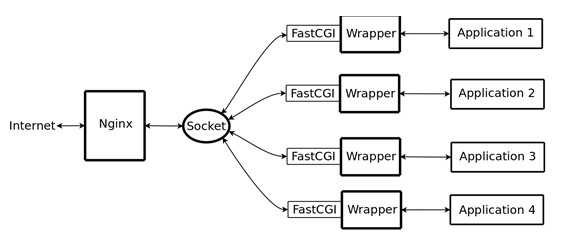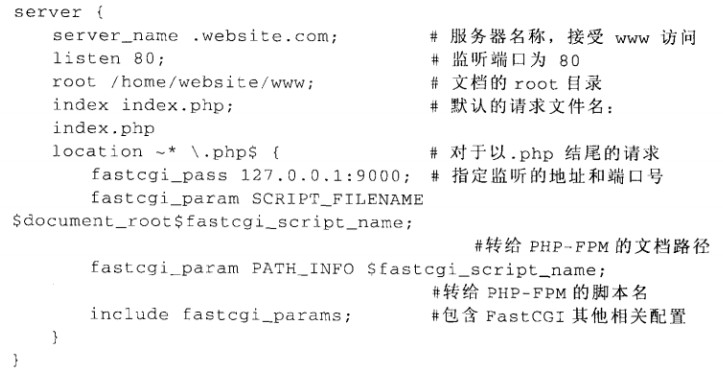How to configure and optimize FastCGI in Nginx
fastcgi:
fastcgi is developed and improved from cgi. The main disadvantage of the traditional cgi interface method is poor performance, because every time the http server encounters a dynamic program, the script parser needs to be restarted to perform parsing, and then the results are returned to the http server. This is almost unavailable when dealing with high concurrent access. In addition, the traditional cgi interface method has poor security and is rarely used now.
The fastcgi interface mode adopts the c/s structure, which can separate the http server and the script parsing server, and start one or more script parsing daemons on the script parsing server. Every time the http server encounters a dynamic program, it can be delivered directly to the fastcgi process for execution, and then the result is returned to the browser. This method allows the http server to exclusively process static requests or return the results of the dynamic script server to the client, which greatly improves the performance of the entire application system.
nginx does not support direct calling or parsing of external programs. All external programs (including PHP) must be called through the fastcgi interface. The fastcgi interface is a socket under Linux (this socket can be a file socket or an ip socket). In order to call a cgi program, a fastcgi wrapper is also needed (a wrapper can be understood as a program used to start another program). This wrapper is bound to a fixed socket, such as a port or file socket. When nginx sends a cgi request to this socket, through the fastcgi interface, the wrapper receives the request and then spawns a new thread. This thread calls the interpreter or external program to process the script and read the return data; then, the wrapper The returned data is passed to nginx along the fixed socket through the fastcgi interface; finally, nginx sends the returned data to the client. This is the entire operation process of nginx fastcgi. The detailed process is as shown in the figure.

Example:

Optimization configuration example of fastcgi parameters in nginx
After configuring nginx fastcgi, in order to ensure the high-speed and stable operation of the php environment under nginx, some fastcgi optimization instructions need to be added. An optimization example is given below. Add the following code to the http level in the nginx main configuration file.
fastcgi_cache_path /usr/local/nginx/fastcgi_cache levels=1:2 keys_zone=test:10m inactive=5m; fastcgi_connect_timeout 300; fastcgi_send_timeout 300; fastcgi_read_timeout 300; fastcgi_buffer_size 64k; fastcgi_buffers 4 64k; fastcgi_busy_buffers_size 128k; fastcgi_temp_file_write_size 128k; fastcgi_cache test; fastcgi_cache_valid 200 302 1h; fastcgi_cache_valid 301 1d; fastcgi_cache_valid any 1m;
The meaning of the above code:
In the first line of code, the file path, directory structure level, keyword area storage time and non-fastcgi cache are set. Activity data deletion time.
fastcgi_connect_timeout specifies the timeout for connecting to the backend fastcgi.
fastcgi_send_timeout specifies the timeout for sending requests to fastcgi. This value is the timeout for sending requests to fastcgi after two handshakes have been completed.
fastcgi_read_timeout specifies the timeout for receiving fastcgi responses. This value is the timeout for receiving fastcgi responses after two handshakes have been completed.
fastcgi_buffer_size is used to specify the size of the buffer needed to read the first part of the fastcgi response. This value indicates that a 64kb buffer will be used to read the first part of the response (response header) , can be set to the buffer size specified by the fastcgi_buffers option.
fastcgi_buffers specifies how many and how large buffers need to be used locally to buffer fastcgi response requests. If the page size generated by a php script is 256kb, then four 64kb buffers will be allocated for caching; if the page size is greater than 256kb, then the part greater than 256kb will be cached in the path specified by fastcgi_temp, but this is not Good approach, since data can be processed faster in memory than on a hard drive. Generally, this value should be the middle value of the page size generated by the PHP scripts in the site. If the page size generated by most scripts in the site is 256kb, then this value can be set to "16 16k", "4 64k", etc.
The default value of fastcgi_busy_buffers_size is twice the size of fastcgi_buffers.
fastcgi_temp_file_write_size indicates how large a data block is used when writing cache files. The default value is twice that of fastcgi_buffers.
Enable fastcgi cache and name it refers to the role of fastcgi_cache. Turning on the cache is very useful, it can effectively reduce the load on the CPU and prevent 502 errors from occurring, but turning on the cache can also cause many problems, depending on the specific situation.
fastcgi_cache_valid, fastcgi is used to specify the cache time of the response code. The value in the example indicates that 200 and 302 responses will be cached for one hour, 301 responses will be cached for 1 day, and other responses will be cached for 1 minute.
The above is the detailed content of How to configure and optimize FastCGI in Nginx. For more information, please follow other related articles on the PHP Chinese website!

Hot AI Tools

Undresser.AI Undress
AI-powered app for creating realistic nude photos

AI Clothes Remover
Online AI tool for removing clothes from photos.

Undress AI Tool
Undress images for free

Clothoff.io
AI clothes remover

AI Hentai Generator
Generate AI Hentai for free.

Hot Article

Hot Tools

Notepad++7.3.1
Easy-to-use and free code editor

SublimeText3 Chinese version
Chinese version, very easy to use

Zend Studio 13.0.1
Powerful PHP integrated development environment

Dreamweaver CS6
Visual web development tools

SublimeText3 Mac version
God-level code editing software (SublimeText3)

Hot Topics
 How to allow external network access to tomcat server
Apr 21, 2024 am 07:22 AM
How to allow external network access to tomcat server
Apr 21, 2024 am 07:22 AM
To allow the Tomcat server to access the external network, you need to: modify the Tomcat configuration file to allow external connections. Add a firewall rule to allow access to the Tomcat server port. Create a DNS record pointing the domain name to the Tomcat server public IP. Optional: Use a reverse proxy to improve security and performance. Optional: Set up HTTPS for increased security.
 How to run thinkphp
Apr 09, 2024 pm 05:39 PM
How to run thinkphp
Apr 09, 2024 pm 05:39 PM
Steps to run ThinkPHP Framework locally: Download and unzip ThinkPHP Framework to a local directory. Create a virtual host (optional) pointing to the ThinkPHP root directory. Configure database connection parameters. Start the web server. Initialize the ThinkPHP application. Access the ThinkPHP application URL and run it.
 Welcome to nginx!How to solve it?
Apr 17, 2024 am 05:12 AM
Welcome to nginx!How to solve it?
Apr 17, 2024 am 05:12 AM
To solve the "Welcome to nginx!" error, you need to check the virtual host configuration, enable the virtual host, reload Nginx, if the virtual host configuration file cannot be found, create a default page and reload Nginx, then the error message will disappear and the website will be normal show.
 How to communicate between docker containers
Apr 07, 2024 pm 06:24 PM
How to communicate between docker containers
Apr 07, 2024 pm 06:24 PM
There are five methods for container communication in the Docker environment: shared network, Docker Compose, network proxy, shared volume, and message queue. Depending on your isolation and security needs, choose the most appropriate communication method, such as leveraging Docker Compose to simplify connections or using a network proxy to increase isolation.
 How to register phpmyadmin
Apr 07, 2024 pm 02:45 PM
How to register phpmyadmin
Apr 07, 2024 pm 02:45 PM
To register for phpMyAdmin, you need to first create a MySQL user and grant permissions to it, then download, install and configure phpMyAdmin, and finally log in to phpMyAdmin to manage the database.
 How to deploy nodejs project to server
Apr 21, 2024 am 04:40 AM
How to deploy nodejs project to server
Apr 21, 2024 am 04:40 AM
Server deployment steps for a Node.js project: Prepare the deployment environment: obtain server access, install Node.js, set up a Git repository. Build the application: Use npm run build to generate deployable code and dependencies. Upload code to the server: via Git or File Transfer Protocol. Install dependencies: SSH into the server and use npm install to install application dependencies. Start the application: Use a command such as node index.js to start the application, or use a process manager such as pm2. Configure a reverse proxy (optional): Use a reverse proxy such as Nginx or Apache to route traffic to your application
 How to generate URL from html file
Apr 21, 2024 pm 12:57 PM
How to generate URL from html file
Apr 21, 2024 pm 12:57 PM
Converting an HTML file to a URL requires a web server, which involves the following steps: Obtain a web server. Set up a web server. Upload HTML file. Create a domain name. Route the request.
 What to do if the installation of phpmyadmin fails
Apr 07, 2024 pm 03:15 PM
What to do if the installation of phpmyadmin fails
Apr 07, 2024 pm 03:15 PM
Troubleshooting steps for failed phpMyAdmin installation: Check system requirements (PHP version, MySQL version, web server); enable PHP extensions (mysqli, pdo_mysql, mbstring, token_get_all); check configuration file settings (host, port, username, password); Check file permissions (directory ownership, file permissions); check firewall settings (whitelist web server ports); view error logs (/var/log/apache2/error.log or /var/log/nginx/error.log); seek Technical support (phpMyAdmin






